![]()
![]()
![]()
Use LEFT and RIGHT arrow keys to navigate between flashcards;
Use UP and DOWN arrow keys to flip the card;
H to show hint;
A reads text to speech;
28 Cards in this Set
- Front
- Back
|
Why do we believe that schizophrenia is a neurodevelopmental problem vs. a neurodegenerative issue now?
|
1. MRI reveal cranium is small in additional to frontal lobe/cerebrum: suggests a developmental problem
2. Neuropathology not consistent with neurodegeneration (instead of neuronal loss/gliosis there is increased neuronal density) |
|
|
What is the neurodevelopmental hypothesis?
|
1. Pathologic process that begins before brain reaches adulthood
2. Genetic and environmental factors at play 3. Abnormalities lead to activation of pathologic neural circuits during adolescence that lead to + and - symptoms 4. Stress contributes to the progression/manifestation of disease |
|
|
What are some environmental/fetal risk factors for developing scz?
|
1. Early fetal factors: ob complications, maternal nutrition, influenza (winter-spring birth excess)
2. Environmental risk factors: urban residence, migration, childhood adversity, stress |
|
|
Approximately ___% of the risk of acquiring scz can be assigned to genetic transmission.
|
80%
*complex mode of transmission compatible with multi locus model; NOT AD |
|
|
What types of candidate genes are suspected to be involved? (i.e., what processes are they involved in?)
|
neurodevelopment, neuroplasticity, and neurotransmission
|
|
|
1. What is COMT(catechol-o-methyltransferase) involved in? What are the two genotypes?
2. What did the COMT genotype x Marijuana (Caspi et al.) reveal about gene-environment interactions? |

1. COMT is involved in metabolizing dopamine after it has been released into the synapse. There are two COMT genotypes: val (BAD at cleaning up) and met (GOOD at cleaning)
2. The study revealed that genetic and environmental factors both play a role in developing scz. Adolescents with the val/val allele (genetic risk factor) who smoked marijuana (environmental risk factor) were more likely to develop scz than those with met/met or val/met alleles (or val/val w/o marijuana use). |
|
|
What is the effect of in utero maternal depression and parental psychosis on offspring having scz?
|
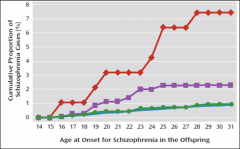
A Finnish study showed that offspring who had both risk factors (maternal depression and parental psychosis) were at a MUCH higher risk of scz than with either factor alone (multiplicative effect?).
*the red line |
|
|
Where are changes are evident in the gross anatomy of the brain?
|
1. Enlarged lateral and third ventricles
2. Reduced whole brain size; reduced cortical gray matter volume 3. prefrontal cortex 4. medial temporal lobe 5. thalamus (medial dorsal nucleus) |
|
|
1. Where are there progressive reductions in the brain? 2. Where is there NO volumetric change?
|
1. Reductions in:
whole brain, whole brain gray matter, frontal lobe volumes white matter: frontal, parietal, and temporal lobe grey matter: starts at parietal cortex and spreads into temporal and prefrontal cortices (also, ventricles are increasing over time) 2. No changes in medial temporal lobe subregions (amygdala, hippocampi) |
|
|
There is an increased density of _________ neurons in the ________ prefrontal cortex (PFC) of patients with scz.
|
pyramidal, dorsolateral
**Increased density due to decrease size, dendrite length, and spine density of pyramidal neurons |
|
|
1. What is hypofrontality?
2. What scz symptoms does this explain? 3. Is there a decrease or increase in dopamine activity in this particular area? |
1. A phenomenon in which patients cannot activate the prefrontal cortex.
2. Explains cognitive insufficiency symptoms. Decrease in executive functioning (planning, initiating, monitoring), increase in apathy, behavioral problems 3. decrease |
|
|
What sorts of dysfunction is seen in the medial temporal lobe?
|
1. Mild cortical atrophy
2. Cortical neuronal disarray 3. Smaller hippocampal size Functional MRI abnormal (less blood perfusion) when performing declarative memory tasks (hippocampus-related) **medial temporal lobe structures: amygdala, entorhinal cortex, hipocampus |
|
|
1. What specific area of the thalamus is affected in scz? 2. How could this explain some of the cognitive symptoms of scz?
|
1. Mediodorsal nucleus (MD nucleus); decreased glucose metabolism is seen
2. The mediodorsal nucleus has projections to the prefrontal cortex. Thus, deficits in this area could contribute to difficulties filtering stimuli and focusing attention. |
|
|
You are a neonate monkey who just suffered some sort of anoxic injury that has caused a lesion in the hippocampus. Given the "feed-forward effect" of neural circuitry, what do you suspect may also be affected?
|
Lesions in the hippocampus lead to prefrontal cortex abnormalities. Lesions in the prefrontal cortex lead to excess dopamine in the basal ganglia. Excess dopamine in the basal ganglia not only leads to psychotic symptoms but also feeds back to prefrontal cortex regulation.
**seems pretty speculative |
|
|
What are the three key neurotransmitters that are dysfunctional in scz?
|
dopamine, glutamate, GABA
|
|
|
What supports for the dopamine hypothesis? (the hypothesis being that excess dopamine is related to scz)
|
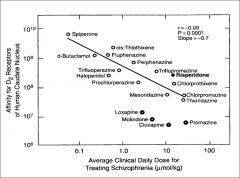
1. All antipsychotics block D2 receptors. (ex. thorazine)
2. Dopamine agonists can cause psychosis (ex. amphetamine) 3. The higher the affinity for D2 receptors an antipsychotic has, the lower the effective treatment dose is. |
|
|
What are the four dopamine pathways and what are they involved in? How are they dysregulated in scz?
|
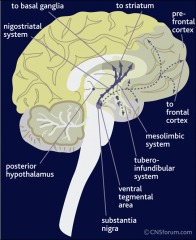
1. Nigrostriatal: movement (parkinsonism)
2. Mesolimbic: emotional behavior (increased in scz, results in + scz symptoms like delusion) 3. Mesocortical: cognition/behavior (decreased in scz, results in - and cognitive symptoms of scz) 4. Tuberinfundibular: prolactin regulation (side effect of scz meds) |
|
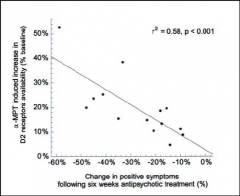
What does concept does this graph illustrate?
Title: Increased baseline occupancy of D2 receptors by dopamine in schizophrenia. |
Increase in D2 receptor occupancy at baseline was associated with a greater response to treatment with neuroleptic medication. Patients with a higher occupancy responded better to treatment (because the treatment directly affected their problem: excess dopamine); patients who did not have a high baseline occupancy did not respond well (dopamine was not their problem) suggesting there are other mechanisms besides dopamine that lead to psychosis in some patients.
|
|
|
What clinical findings suggest that glutamate could be involved?
|
PCP + Ketamine-- antagonists at the glutamate NMDA receptor-- can induce a SCZ-like psychotic state. Tehy can also induce the NEGATIVE symptoms of scz, unlike dopamine.
|
|
|
Explain regulatory effects of the direct and indirect glutamate pathways (glutaminergic neuron) on a monoaminergic neuron.
|
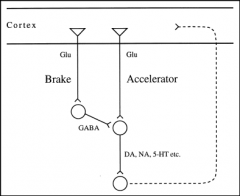
1. Direct: Glutamanergic neuron directly stimulates a monoaminergic neuron to fire; acts as an accelerator
2. Indirect: Glutaneurgic neuron first hits a GABA interneuron which then inhibits firing of a monoaminergic neuron; acts like a brake |
|
|
How do problems with glutamate receptors dysregulate the mesolimbic and mesocortical pathways?
|
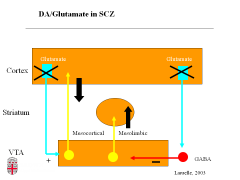
1. Mesolimbic: Glutamatergic neurons from the prefrontal cortex normally inhibit firing of the mesolimbic pathway via indirect pathway. In dysfunction, there is a reduction of inhibition, resulting in increased mesolimbic activity (positive symptoms: delusion).
2. Mesocortical: Glutaminergic neurons normally promote firing of mesocortical pathway. In dysfunction, there is less stimulation, resulting in decreased mesocortical activity (negative and cognitive symptoms). |
|
|
What (broad) changes are there when there are glutamate and GABA problems?
|
1. dysregulation of normal cortical function
2. dysregulation of regulatory neurotransmitters results in dysregulation of a lot of other neurotransmitters leading to problems with cell survival, function, and communication |
|
|
What type of GABA neuron is affected in scz? Do postmortem studies reveal an increase or reduction in cortical GABA?
|
Chandelier neurons, decrease
|
|
|
Hyperactivity of dopamine at the D2 receptors in the _______________ leads to psychotic symptoms.
|
basal ganglia
|
|
|
What contributes to the negative and cognitive symptoms of scz?
|
problems in the prefrontal cortex (mesocortical pathway)
1. altered neurotransmitter (dopamine, GABA, glutamate) in the prefrontal cortex 2. deficits in neuronal structure/blood flow |
|
|
Fill in the neurotransmitters: __________ and _________ dysregulation may contribute to dopamine dysregulation.
|
Glutamate, GABA
|
|
|
True or False: Schizophrenia is likely a heterogeneous disorder.
|
True.
|
|
|
Big picture: Gross anatomy involved? Neurotransmitters involved?
|

|

